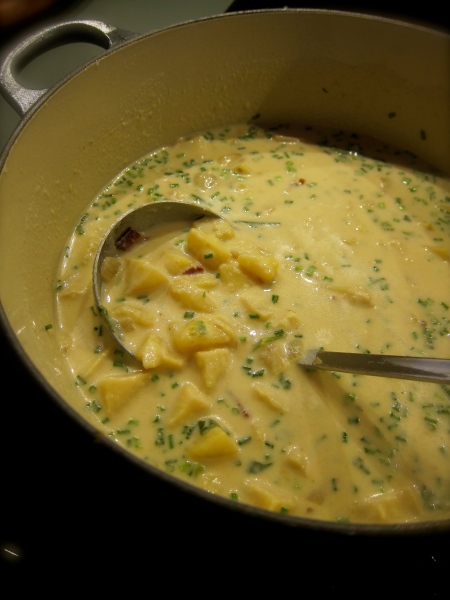Described as having “hints of mace, cinnamon, celery seed, and clove,” the flavor that most came to mind when I first tasted parsnips was coconut. I was in my 20’s, living in New York, and visiting friends in the country for Thanksgiving. The morning after, my friend sauteed some kale, and then some parsnips to have along with our turkey sandwiches. The two were new to me and though I liked both, what I really wanted more of were the parsnips.
There’s an old New England superstition that believes “Parsnips are poison unless they are first frozen,” which may have something to do with the confusion between poison hemlock and wild parsnip. Nevertheless, parsnips left to sweeten overwinter in the ground are considered a treat here. We buy the spring-dug parsnips when we happen across them at the farmers’ market, but that’s still a ways off and I made do with some that had been stored — they don’t have the same complexity of flavor, but remind me that spring is near.
Farmhouse chowder, unlike the more well-known New England one, omit the seafood and are all about making do with what’s on hand. This one relies on the quality of its few ingredients, letting the earthy sweet, almost floral flavor of the parsnips shine through. I used leeks instead of onions, and prefer using cream rather than milk in order to keep the chowder from curdling when, inevitably, I let it overboil. Like most dishes of this nature, the flavor improves if it’s let to sit overnight.
Spring-Dug Parsnip Chowder
3 ounces salt pork (or bacon), rind removed and cut into 1/3-inch dice
2 tablespoons butter
1 large onion (10 ounces) cut into 3/4-inch dice
1 pound parsnips, peeled and sliced into rounds
1 pound potatoes, peeled and cut into 3/4-inch dice
3 cups chicken stock
1 1/2 cups heavy cream
Sea salt and freshly ground black pepper
Chives, chopped (or parsley, celery leaves)
– Render the diced salt pork in a heavy pot over low heat until it releases a few tablespoons of fat. Increase the heat, add the butter and onion, and saute until the onion is tender but not browned. Add the parsnips, potatoes, and stock, and bring to a boil. Cook vigorously for about 10 minutes, or until the vegetables are barely tender. Reduce the heat to low.
– Remove 2 cups of the chowder from the pot and puree in a food mill or processor, then return it to the chowder. Stir in the cream, and let the chowder simmer slowly for another 5 minutes; the broth should look silky-smooth. Remove from heat, and season with salt and pepper.
– If not serving within the hour, let cool then refrigerate; cover after it has chilled completely. Otherwise, let it set at room temperature for up to an hour, allowing the flavors to meld. When ready to serve, reheat the chowder over low heat; don’t let it boil. Garnish with minced chives, parsley or celery leaves.
Recipe adapted from “50 Chowders” by Jasper White.
Local ingredients: Parsnips and butter from Brookford Farm; cream from Harris Farm; Keuka Gold potatoes from Riverside Farm; bacon from New Roots Farm; leeks and chives from the garden; homemade chicken stock.




Oh yum – this sounds delicious, especially as the temperature has dropped here (only for a day or day but dropped nonetheless) so I feel like soup again.
And here I’ve been envious of all of your fresh salads, and the weather to enjoy them in!
Oh boy, that looks amazing!
Thanks, Robin — it was even better the second time around!
The finished product does look inviting… my experience with parsnip is that they taste like something in between carrots and potatoes… no?
Close in shape and sweetness of carrots, with a softer texture than potatoes. Part of eating locally is noticing the flavor changes through the seasons and in storage…
That sounds fantastic. I can almost smell it! Three cheers for local ingredients — I used to live up the street from New Roots when they were getting started up.
Thanks, Brian — Jeff and Renee do a great job. It’s been wonderful to watch them grow through the years and expand their offerings, making it increasingly easier for us to source locally.